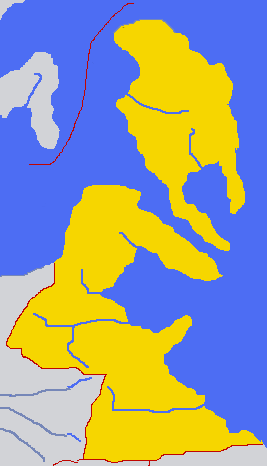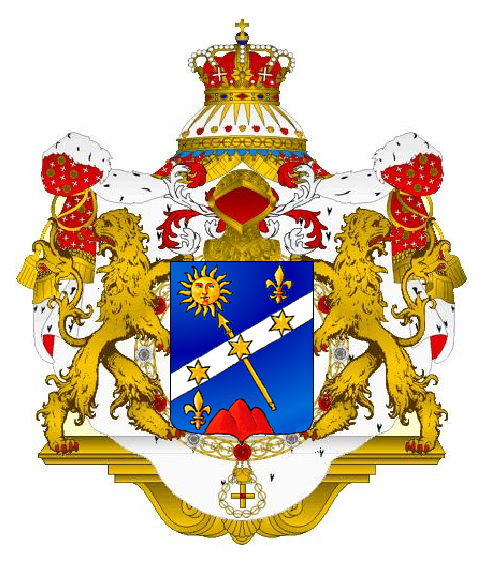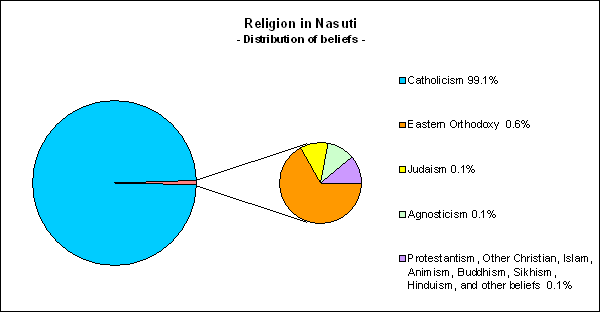Nasuti
| Principato Romano Cattolico di Nasuti | |
|---|---|
| Motto - English |
motto in latin? motto in english? |
| Anthem | Ira Tenax (Listen) |
| Official Language(s) | Italian, Lancianese |
| Capital | Roccaforte di Nasuti |
| Government | Hereditary Monarchy |
| Title | His Catholic Majesty Prince |
| Leader | Cris I of the Sovereign Royal Family of Nasuti |
| Population | over 1 billion |
| Establishment - Foundation of Samnium - Municipium of Anxianum - League of Samnium - Domination of Lanciane - Coronation of 1st King - Constitutional Monarchy - Complete Kingdom - Roman Catholic Princedom |
- 1100 b.C. - 132 b.C. - 1112 - 1572-1715 - 1780 - 1890 - '50s - 2007 |
| Area - Area - % water |
xx km. sq. xx% |
| National Colors | Black, Gold Yellow and White |
| GDP - Total (USD) - Per Capita (USD) |
See our real time stats |
| Currency | Lira del Camerlengo |
| Exchange Rate | See our real time stats |
| Tech Level | Post Modern Tech |
| Patrons | - Madonna del Carmine - Santa Lucia - San Gabriele - Sant'Amato |
| National sport(s): | car races on circuit, soccer, swim |
| Stats: NS Sunset Pipian NSTracker NSEconomy NSTracker XML | |

Principato Romano Cattolico di Nasuti (The Roman Catholic Princedom of Nasuti) is a Nation of the region Catholic, member of UN, member of Catholic Council and signer of the Catholic Charter. The capital city is Stronghold of Nasuti, a town built around to a medieval fortress. The Roman Catholic Princedom of Nasuti refer itself whit short form Nasuti.
The official language of the Nasuti is Italian, but a lot citizen speak (not exist a reference text for coding the writing) an ancient language called "Lancianese" native of the ancient domination that the Princedom was submitted.
Nation's adjectival form is Nasutian (Nasutere in Lancianese) and and it is the same for noun for persons from this nation.
The population is over 1 billion with continuous growth. Nasuti population achieve the record of 1 billion within the end of the year 2007, outclassing the prevision of analyst.
Major ethnic groups is Italic Nasutian (95%), German (2%), English (2%), French (0.5%) and Polish (0.5%).
The Holy Flag of the Principato Romano Cattolico di Nasuti is, from left to right, black, white and gold yellow, with the coat of arms of the Sovereign Royal Family on the white cloth.
Contents
Story of Nasuti
From foundation to Lanciane's Domination
The story and the legend tells that the first village of the Princedom was Samnium, whose origin comes make go back around 1100 BC. Subsequently in Roman period the villages became a colony of the Republic, with the name of Castra Samnium. Castra Samnium became Municipium in 132 b.C. with the name of Anxianum and it had this status until the barbaric invasions. Whit the statal reform of Augustus Regio Samnium became the name of the region under the controll of Anxianum.
With the arrival of the first Christian evangelist, the populations of the region converted themselves immediately to the Christianity, recognizing the True God and the True Faith. The Christian community had immediately lively exchanges with the Bishops of Rome and did not embrace any heretical theory of paleo-Christian period.
During fall of the Western Roman Empire, the Samnium Region was sacked by the Goths, and Anxianum was partially destroyed during the Lombard invasion (c. 570 AD). In 610, however, the region was conquered by the Byzantines, who found the Ducato di Samnium (Duchy of Samnium) and allowed the trades to restart. In the late 8th century the Duchy was conquered by the Franks, who fight against the Muslim pirates with the precious help of the people of the region.
In 9th century the Duchy divided themselves and Anxianum returned independent with the name of Anxano Sannita. In the medieval age in all of the region came built some outposts fortified, particularly the most large it was the Fortezza del Samnium (Fortress of the Samnium) in the Anxano Sannita and a new settlement was then created around the castle.
In 1060 the Normans made the region a centre of trade and Anxano Sannita receiving important privileges by both Frederick II and his son Manfred, with a substantial administrative autonomy. With a new period of development and of flowering of the commerce, the region expanded themselves until to occupy almost all of the current area, with the annexation in the sphere of influence of the territories of Rizzacorno, Riegne, and Feltrin, left after the barbaric invasions and now returned to shine thanks to the commerce. The power was managed from noble faithful to the Holy Roman Empire but during the conflict between Pope and the Empire, although the noble are lined up with the Emperor, the people rhymed faithful to the Pope. In 1112, after hunted it of the "unfaithful noble", many territory of the region (Castello Frentan, Teate, Solomona, Villa Ripa) decided to unite with Anxano Sannita in a commercial and politic union called Lega del Samnium (League of Samnium) that give a reasonable independence. Many free citizens of the league enlisted voluntarily to participate at the Crusades for the liberation of the Holy Land and, besides in middle east, they should confront the Muslim also on the native ground, threatened by the continuous raids.
The independence, the privileges and the commercial riches developed still of more in the Renaissance collapsed with the civil war against the Ducato di Lanciane (Duchy of Lanciane), that invaded all the member of the League in 1572 and subjected it until the 18th century. The new dominator governed with iron fist and despotism, until the crash with some of the religious authority of the region. However under the domination fermented the seeds of the revolution and more times local rebellions had been suffocated in the blood. In 17th century also the Duchy was devastated from the plague and economical crisis became more strong contributing to the growth of the popular discontent. Track of the dark period of the domination is remained only in the language speak by a lot citizen, without hatred for the inhabitants of Lanciane. In fact, with the increase of rebellions, the Duchy began to fall in a more internal deep crisis and to the moment of the definitive crash, fortunately, the people of dissolved dominator and their brothers of the new Kingdom have chosen the way of the reconciliation in Christ.
The Rebellion an the Kingdom
In 1715 began the general rebellion that carried first to the rebellion of all of the people against the Duchy and then to the independence of the community. The rebellion was driven from some limb of the people and from some old noble noble of the pre-domination: with a series of committees they drive the rebels to the victory with the minimum crashes and convincing also the original citizens of the Duchy. After the victory, for the temporary government, was created an assembly of heroic rebels and wise, the Concilio dei Saggi e dei Coraggiosi (Council of Sages and Braves). After little years the Council decided to create an united kingdom where could adhere all the local regions. The sovereignty had entrusted to the family of the most courageous commander of rebellion, Lord Ferdinando Domenico Nasuti Barone della Roccaforte di Anxano (Baron of Stronghold of Anxano, the new name of Anxano Sannita).
The first one King was Nicola I the Great, grandchild of Ferdinando Domenico, crowned Re del Samnium (King of Samnium) in 1780. His father, Domenico Nasuti, was a member of Council for 25 years and Chief of Council for his last 5 years of life; he proposed the idea of a Kingdom 20 years before the coronation of his son. Nicola I, admirer of the struggle for the independence of the USA and of their constitutional democracy, basins the first democratic Constitution that established the power of the King and the power of the Council of Sages and Braves. He fixed the capital in Roccaforte di Anxano and he consolidated the absolute relations of faithfulness to the Pope and to the Roman Catholic Church with an agreement and oath both valid for all of the its sovereigns successors.
During the kingdom of Ferdinando I the Charitable and Gildo I the Just, the trouble of death was progressively abolished and was founded the Congregazione per la Legge dei Laici (Congregation for the Law of the Laymen) for the management of the justice. Besides also in the kingdom appeared the industrial revolution, that in little years fixed the economy of the region and carried the economical development to a level ever reached first without the exploitation of the proletariat thanks to the farsighted application of the social doctrine of the Church forced by the Sovereigns and the religious authority.
In 1890 King Gildo III the Reformer decided to substitute the Council of Sages and Braves with the Senato dei Fedeli (Senate of the Faithful) and reform the state establishing the present type of government (with the division of the power betweeen the King, the Senate of the Faithful and the Congregation for the Law of the Laymen); the last session of the Council of Sages and Braves decided to change the name of the Kingdom with the name of sovereign family: the Kingdom of Samnium became the Monarchia Costituzionale di Nasuti (Constitutional Monarchy of Nasuti). The Kingdom did not participate to the World Wars I.
In 1930, for the 150th anniversary of the coronation of Nicola I the Great and of the kingdom of the Nasuti, King Domenico I and the Senate of the Faithful approved the change of the name of the capital in Roccaforte di Nasuti.
King Domenico II the Peaceful guaranteed the neutrality of the kingdom during World Wars II and the neighboring indipendent regions of Gaeta and Costa di Teate asked of to be annas to the kingdom.
King Raffaele I and his son Nicola II inaugurated the season of the "short and modern kingdom": both after little years of kingdom have abdicated in favor of the sons. In 1980, after little months from its coronation, the King Nicola II celebrated the 200th anniversary from the coronation of its homonymous predecessor Nicola I. In 200 years it was ensured to the Kingdom the peace and the calm, the development and the well-being. Some intellectual of the Nation advanced the idea of a "Pax Nasuti", but the King denied his support to this conviction remembering that the "only peace is in Christ and not in the men".
After the abdication of King Nicola II, the King Cris I announced a referendum that changed the Constitutional Monarchy to Princedom, taking again in part the ancient title of "Roman Catholic". The new name is the current: Principato Romano Cattolico di Nasuti (Roman Catholic Princedom of Nasuti). The Pricnipe Cris I has wanted the presence of its two enlightened predecessors to its flank in the government of the Princedom.
Sovrana Famiglia Reale di Nasuti
| See also Sovrana Famiglia Reale di Nasuti. |
The Sovrana Famiglia Reale di Nasuti (Sovereign Royal Family of Nasuti) is a dynasty of nobles who descend from Lord Ferdinando Domenico Nasuti Baron of Stronghold of Anxano, the most courageous one of the commanders of rebellion of 1715.
The 1st King was Nicola I the Great, grandchild of Ferdinando Domenico, crowned King of Samnium in 1780.
In 1890 the Kingdom of Samnium became the Constitutional Monarchy of Nasuti.
In 2007, after a referendum, became Roman Catholic Princedom of Nasuti, and the King of Nasuti became Price.
The Residences of the Sovereign Royal Family of Nasuti is Fortezza di Samnium in the capital Roccaforte di Nasuti.
Politics and Government
| See also Nasuti's Politics and Government. |
Nasuti is a Constitutional Princedom with separation of powers: legislative to the Senato dei Fedeli (Senate of the Faithful); executive to the hereditary Prince with title of Sua Maestà Cattolica Principe (His Catholic Majesty Prince); justice to the Congregazione per la Legge dei Laici (Congregation for the Law of the Laymen).
Head of State is Sua Maestà Cattolica Principe Cris I (His Catholic Majesty Prince Cris I) and his vice is Bishop or Cardinal of the diocese named by the Pope.
Geography of Nasuti
The territories of Nasuti are the mainland in south and a big island Sabina Superba in north. Nasuti is surrounded in north and east by the waters of Mare Samnium (Samnium Sea).
The north-east coast is dominated by the Distesa Sabinica Superiore (Upper Sabinic Expanse), that it is extended until the Panisola Rizza (Peninsula Rizza) on south-east of the island. Into north of the island, behind the Distesa Sabinica Superiore, there it is the mountainous massif of the Aldana, where is the woodland park of Gaeta around the mount. In the central weast part of the island there is the river Feltrin that go to sea from the mount of Corno (in central east part of the island) to the west in the Piana Feltrina (Feltrina Plain), the biggest fluvial plain of the island. Under the Piana Feltrina, in south west, there are the plain of Distesa Sabinica Inferiore (Lower Sabinic Expanse) that it is extended until the Penisola Ripa (Penisula Ripa) in the south-west, the longest peninsula of the island. From the Corno come down to south the river Trino, that flow in the water of the Golfo di Cesia (Cesia's Gulf), the gulf between the two peninsulas.
The north-western part of the north mainland is occupied by the Piana Marittima Teatina (Teate's Maritime Plain), while in east there is the Penisola Cimanica (Cimanic Peninsula) that is separated from the island by the waters of Stetto Julianico (Julianic Strait). Behind the Piana Marittima Teatina, at the center of north part of the mainland, there is the mount Cimana from that it gushes the river Lia. Between this river and the parallel Pia, to south, it is extended Piana Seroli (Plain Seroli). Under the Pia there is the Piana del Sangro (Sangro's Plain), terminated in south by the Sangro and its first tributary Majico that gushes from the mount Carmelo in the extreme east. Between the Carmleo at east, the river Majico at north and river Goltico at south, there is the Valle del Carmelo (Carmelo's Valley). Goltico is the second tributary of the Sangro and the pair of river sourround Piana del Goltico (Goltico's Plain), that is limited, at south, by the mount Golgon where gushes the Goltico. From the mountainside to the sea there is the Penisola Franca (Peninsula Franca). Along the remaining southern coasts there is Piana Marittima di Carolina (Carolina's Maritime Plain), while the inside territory is horizontally cut by the river Anxan, that gushes from the south side of the Golgon. Finally in the south boundary of Nasuti there are the Valli Meridiane (Meridian's Valleys), the valleys of the mount Corno Meridia, the extreme south boundary of Nasuti.
Nasuti's administrative division
| See also Nasuti's administrative division. |
The Princedom is divided in 12 Regions, with a limited local autonomy, derived from the ancient territories of the Regio Samnium. In the north island Sabina Superba there are 5 region: Ducato di Gaeta (Duchy of Gaeta), Contea di Riegne (County of Riegne), Contea di Feltrin (County of Feltrin), Contea di Rizzacorno (Earldom of Rizzacorno) and Villa Ripa. In the south, on mainland, there are other 6 regions and the capital district: Costa di Teate (Coast of Teate), Solomona, Teate, Samnium (capital district), Valle del Carmelo (Valley of Carmelo), Castello Frentan (Castle Frentan) and Ducato di Lanciane (Duchy of Lanciane).
The first territorial unit of the Princedom, that sinks his roots in the League of Samnium, is managed from local officials directly elected from the citizens. This type of region are Castello Frentan, Teate, Solomona, Villa Ripa, and Valle del Carmelo. Costa di Teate, before the union with the Princedom, was a republic and maintained part of the republican structures for the local administration. The Ducato di Gaeta, like Costa di Teate, after the union with the Princedom maintained also its administrative equipment governed by the Duca di Gaeta. The thre County, Rizzacorno, Riegne and Feltrin, also are managed by the respective noble families with a part of the officials elected by the citizens. Finally the Ducato di Lanciane maintained its nobility only in name. The old lords of the period of the oppression have not heirs and the Duchy is passed between different noble families of the region. Besides its administrative structure is totally elective except for the leading of the local government that is entrusted to the ducal family. While the other regions enjoy of a reasonable administrative autonomy, Samnium is a special region than has not a self-govern because traditionally was the heart of the Kingdom and today is the leading power center of the Princedom.
Religion
The religion is a fundamental appearance of the life of the state and of the citizens. The Official State Religion is Roman Catholic (professed by 99% of citizens): Nasuti is a nation of Christians loyal to the traditions of the Roman Catholic Church and obedient to Supreme Pontiff Pope Benedict XVI. The Nasutian are faithful to the moral and to the teachings of Jesus Christ and of His Church.
Other Religions is professed by 1% and to them is guaranteed the freedom of religion and the independence from Catholic Church authority with special law.
Police of Princedom
| See also Police of Nasuti's Princedom. |
Police of Princedom is a civil agencies empowered to use force and other forms of legal coercion and legal means to effect public and social order. The Police of Princedom responsability is of Minister of the Interiors and of the Defence and he is subordinated to the authority of the Prince.
The police agents are authorized to exercise the police power in all Princedom, but they are belonged to different Regional Departments. Regional Departments are divided in Urban Departments (for major cities and suburbs) and Territorial Districts (for minor cities or rural area).
Emergencies and Rescue Management Corp
Emergencies and Rescue Management Corp (Corpo di Gestione delle Emergenze e dei Soccorsi, CGES) is a regular civil corp for the management of emergencies and rescue, like natural disasters, fire, situations of danger for the civilians, etc.
CGES's purpose is to coordinate the response to an emergencies and rescue which has occurred in the Princedom. On-the-ground support is a major part of CGES's activity, but the agency provides experts in specialized fields and funding for rebuilding efforts and relief funds for individual citizens and infrastructure, in conjunction with the public administration. CGES also assists individuals and businesses with low interest loans and also provides funds for training of response personnel throughout the Princedom.
In past the tasks of the CGES had entrusted at different public departments managed by the local authority, armed forces and health service. Only in the 1950's the government decided to create a national corp that it is occupied specified of emergencies and rescues.
Volontaries for Red Cross of Princedom
Volontaries for Red Cross of Princedom (Volontari per la Croce Rossa del Principato, VCRP) is a humanitarian organization that provides emergency assistance, disaster relief and education inside the Princedom, as part of the IFRC.
Today, in addition to domestic disaster relief, the VCRP offers compassionate services in five other areas: community services that help the needy; support and comfort for military members and their families; the collection, processing and distribution of lifesaving blood and blood products; educational programs that promote health and safety; and international relief and development programs.
Governed by volunteers and supported by community donations, the VCRP is a nationwide network dedicated to saving lives and helping people prevent, prepare for and respond to emergencies. Volunteers and employees relief to families affected by disasters, train many people in lifesaving skills and exchange emergency messages for military service personnel and their families. The VCRP also assists victims of international disasters and conflicts at locations worldwide.
Civil Life
Familiar politics
In the 1970s , while the big part of the world proceeded with the approval of rules for the demographic control, the government of the Princedom decided to apply a politics against tendency that they aimed to the protection of the families and to their development. They were introduced familiar cheque for the sons, introduced the system of taxation based on the familiar quotient, favored the opening of nursery school for the son of couples of workers, etc.
After almost 30 years of application, the Prince Cris I declared to is not intentioned to leave this politics but, contrariwise, will invest even more resources.
Thanks to the politics of the Government for the protection of the family and the development of the population, the Princedom of Nasuti had celebrated at the endings of July the achievement of 1 billions of inhabitants before the esteem of october 2007.
School
In Nasuti the education entrusted by the Integrated Catholic Educational System:
- Nun's Nursery Pubblic School for Childhood and Babyhood or privates nursery, voluntary from 0 to 5 year; - Jesuit Catholic School, obligatory from 5 to 18 year; - Catholic University;
After the protests of a group of not Catholic, in 1905 the government established that for not Catholic there is voluntary abstention from some disciplines, to replace with other choices from the Gathering for the Law of the Laymen.
Anthem: Ira Tenax
Male sit tibi tenebrarum rex
ab initio ad finem sacra ultio
cruenta pugna et epicus furor
contra mali discipulos
Ad perpetuam gloriam lucis
furor ira tenax
contra iniuriam et ruinam
rabies ira tenax
Male sit tibi tenebrarum rex
cruentus rex
(Luca Turilli ed Alessandro Staropoli)
Forze Armate di Nasuti
| See also Forze Armate di Nasuti. |
The Forze Armate di Nasuti (FAN, Military Forces of Nauti) include all military of the Princedom and are lead by Comandante Supremo capo delle Forze Armate (CSFA, Supreme Commandant chief of the Military Forces) William Adama, chosen from Prince Nicola II when it governed and maintained in service from Prince Cristian I for military merits. the Supreme Commandant has a partial autonomy but obeys directly to the Prince.
An esteem (the number is not precise for the secret composition of some special departments) attributes to the FAN as regular fighting enlisted and trained 0.25% of population.
The Constitution and the moral of Nasuti expects the use of the FAN only for defend the Nation and its allies, but refuses the use of the force like tool of aggression and submission.

















